
Leporidae is a family of small mammals in the order Lagomorpha. A member of this family is called a leporid, or colloquially a hare or rabbit. They are widespread worldwide, and can be found in most terrestrial biomes, though primarily in forests, savannas, shrublands, and grasslands. Leporids are all roughly the same shape and fall within a small range of sizes with short tails, ranging from the 21 cm (8 in) long Tres Marias cottontail to the 76 cm (30 in) long desert hare. Most species do not have population estimates and some are not yet evaluated for conservation status, though nine species are considered endangered and one, the riverine rabbit, is critically endangered with a population size of as low as 100. The domestic rabbit subspecies of the European rabbit has been domesticated.
The 64 extant species of Leporidae are contained within 11 genera. One genus, Lepus, contains 32 species that are collectively referred to as hares; the other eight genera are generally referred to as rabbits, with the majority – 19 species – in Sylvilagus, or the cottontail rabbits. Over one hundred extinct Leporidae species have been discovered, though due to ongoing research and discoveries the exact number and categorization is not fixed.[1]
Conventions
| Conservation status | |
|---|---|
| EX | Extinct (0 species) |
| EW | Extinct in the wild (0 species) |
| CR | Critically Endangered (1 species) |
| EN | Endangered (9 species) |
| VU | Vulnerable (8 species) |
| NT | Near threatened (2 species) |
| LC | Least concern (39 species) |
| Other categories | |
| DD | Data deficient (5 species) |
| NE | Not evaluated (0 species) |
Conservation status codes listed follow the International Union for Conservation of Nature (IUCN) Red List of Threatened Species. Range maps are provided wherever possible; if a range map is not available, a description of the leporid's range is provided. Ranges are based on the IUCN Red List for that species unless otherwise noted. All extinct species or subspecies listed alongside extant species went extinct after 1500 CE, and are indicated by a dagger symbol "†".
Classification
The family Leporidae consists of 64 extant species in 11 genera which are divided into over 200 extant subspecies. This does not include hybrid species or extinct prehistoric species.
- Genus Brachylagus: one species
- Genus Bunolagus: one species
- Genus Caprolagus: one species
- Genus Lepus: thirty-two species
- Genus Nesolagus: two species
- Genus Oryctolagus: one species
- Genus Pentalagus: one species
- Genus Poelagus: one species
- Genus Pronolagus: four species
- Genus Romerolagus: one species
- Genus Sylvilagus: nineteen species
Leporids
The following classification is based on the taxonomy described by Mammal Species of the World (2005), with augmentation by generally accepted proposals made since using molecular phylogenetic analysis, as supported by both the IUCN and the American Society of Mammalogists.[2]
| Common name | Scientific name and subspecies | Range | Size and ecology | IUCN status and estimated population |
|---|---|---|---|---|
| Pygmy rabbit
|
B. idahoensis (Merriam, 1891) |
Western America (introduced in red) |
Size: 23–30 cm (9–12 in) long, plus 1–3 cm (0.4–1.2 in) tail[3] Habitat: Shrubland and desert[4] Diet: Sagebrush, as well as grass and other plants[3] |
LC
|
| Common name | Scientific name and subspecies | Range | Size and ecology | IUCN status and estimated population |
|---|---|---|---|---|
| Riverine rabbit
|
B. monticularis (Thomas, 1903) |
Southern South Africa |
Size: 33–47 cm (13–19 in) long, plus 7–11 cm (3–4 in) tail[5] Habitat: Shrubland[6] Diet: Shrubs as well as grass[6] |
CR
|
| Common name | Scientific name and subspecies | Range | Size and ecology | IUCN status and estimated population |
|---|---|---|---|---|
| Hispid hare
|
C. hispidus (Blyth, 1845) |
Himalayas |
Size: 38–50 cm (15–20 in) long, plus 2–4 cm (1–2 in) tail[7] Habitat: Grassland and inland wetlands[8] Diet: Grass as well as other plants[8] |
EN
|
| Common name | Scientific name and subspecies | Range | Size and ecology | IUCN status and estimated population |
|---|---|---|---|---|
| Abyssinian hare
|
L. habessinicus Hemprich, Ehrenberg, 1832 Four subspecies
|
Horn of Africa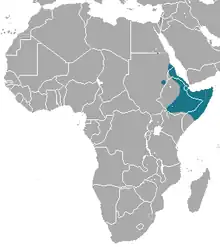 |
Size: 44–45 cm (17–18 in) long[9] Habitat: Savanna, grassland, and desert[10] Diet: Grass, shrubs, and forbs[9] |
LC
|
| African savanna hare
|
L. victoriae Heuglin, 1865 |
Sub-Saharan Africa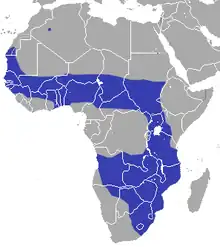 |
Size: 41–58 cm (16–23 in) long[11] Habitat: Savanna, shrubland, and grassland[12] Diet: Variety of plants[12] |
LC
|
| Alaskan hare
|
L. othus Merriam, 1900 Two subspecies
|
Western Alaska |
Size: 50–60 cm (20–24 in) long, plus 6–11 cm (2–4 in) tail[13] Habitat: Forest, shrubland, and grassland[14] Diet: Dwarf willow, grass, sedges, and other plants[14] |
LC
|
| Antelope jackrabbit
|
L. alleni Mearns, 1890 Three subspecies
|
Southwestern North America |
Size: 43–70 cm (17–28 in) long, plus 5–14 cm (2–6 in) tail[15] Habitat: Shrubland, grassland, and desert[16] Diet: Grass, velvet mesquite, and cacti[16] |
LC
|
| Arctic hare
|
L. arcticus Ross, 1819 Four subspecies
|
Arctic North America |
Size: 56–66 cm (22–26 in) long, plus 4–10 cm (2–4 in) tail[17] Habitat: Forest, shrubland, and grassland[18] Diet: Woody plants[18] |
LC
|
| Black jackrabbit | L. insularis Bryant, 1891 |
Tip of Baja California |
Size: 54–61 cm (21–24 in) long, plus 6–12 cm (2–5 in) tail[19] Habitat: Shrubland, grassland, caves, desert, and coastal marine[20] Diet: Grass, as well as tree bark[21] |
VU
|
| Black-tailed jackrabbit
|
L. californicus Gray, 1837 Six subspecies
|
Western and central North America |
Size: 47–63 cm (19–25 in) long, plus 5–12 cm (2–5 in) tail[22] Habitat: Forest, savanna, shrubland, grassland, and desert[23] Diet: Grass and herbs, as well as twigs and bark[22] |
LC
|
| Broom hare
|
L. castroviejoi Arribas, 1977 |
Northern Spain |
Size: 41–59 cm (16–23 in) long[24] Habitat: Forest and shrubland[25] Diet: Grass, herbs, field crops, twigs, buds, and bark[25] |
VU
|
| Burmese hare
|
L. peguensis Blyth, 1855 Two subspecies
|
Southeastern Asia |
Size: 40–59 cm (16–23 in) long, plus 5–9 cm (2–4 in) tail[26] Habitat: Forest, savanna, shrubland, and grassland[27] Diet: Grass, bark and twigs[27] |
LC
|
| Cape hare
|
L. capensis Linnaeus, 1758 Twelve subspecies
|
Africa and western Asia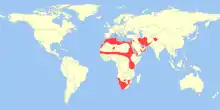 |
Size: 52–60 cm (20–24 in) long[28] Habitat: Shrubland, grassland, and desert[29] Diet: Grass, shrubs, and herbs[29] |
LC
|
| Chinese hare
|
L. sinensis Gray, 1832 Three subspecies
|
Southeastern China and Taiwan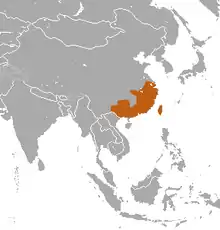 |
Size: 36–42 cm (14–17 in) long, plus 17 cm (7 in) tail[30] Habitat: Shrubland and grassland[31] Diet: Leafy plants, green shoots, and twigs[31] |
LC
|
| Corsican hare
|
L. corsicanus Winton, 1898 |
Southern Italy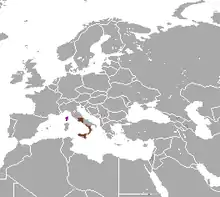 |
Size: 55–61 cm (22–24 in) long[32] Habitat: Forest, shrubland, grassland, and coastal marine[33] Diet: Grass, as well as mint, sedges, rushes, peas, and flowers[32] |
VU
|
| Desert hare
|
L. tibetanus Waterhouse, 1841 Five subspecies
|
Northwestern China |
Size: 40–76 cm (16–30 in) long[34] Habitat: Shrubland, grassland, and desert[35] Diet: Variety of plants as well as seeds, berries, roots, and twigs[34] |
LC
|
| Ethiopian hare | L. fagani Thomas, 1903 |
Ethiopia |
Size: 42–50 cm (17–20 in) long, plus 7–11 cm (3–4 in) tail[36] Habitat: Savanna, shrubland, and grassland[37] Diet: Unknown plants[37] |
LC
|
| Ethiopian highland hare
|
L. starcki Petter, 1963 |
Central Ethiopia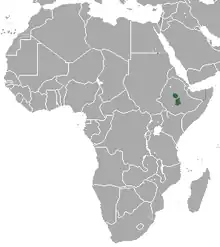 |
Size: 46–60 cm (18–24 in) long, plus 7–12 cm (3–5 in) tail[38] Habitat: Shrubland and grassland[39] Diet: Grass as well as shrubs[39] |
LC
|
| European hare
|
L. europaeus Pallas, 1778 Sixteen subspecies
|
Europe, western Asia, northeastern North America, southern South America, eastern Oceana (introduced in light red) |
Size: 60–75 cm (24–30 in) long, plus 7–11 cm (3–4 in) tail[40] Habitat: Shrubland and grassland[41] Diet: Grass, herbs, field crops, twigs, buds, and bark[40] |
LC
|
| Granada hare
|
L. granatensis Rosenhauer, 1856 Three subspecies
|
Iberian Peninsula (introduced in pink) |
Size: 44–48 cm (17–19 in) long, plus 9–12 cm (4–5 in) tail[42] Habitat: Forest, shrubland, and grassland[43] Diet: Buds, twigs, bark, and crops[44] |
LC
|
| Hainan hare
|
L. hainanus Swinhoe, 1870 |
Hainan Island, China |
Size: 35–40 cm (14–16 in) long, plus 4–7 cm (2–3 in) tail[45] Habitat: Shrubland and grassland[46] Diet: Plants[47] |
EN
|
| Indian hare
|
L. nigricollis F. Cuvier, 1823 Seven subspecies
|
Indian subcontinent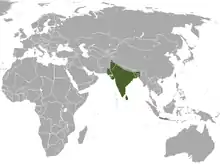 |
Size: 40–70 cm (16–28 in) long[48] Habitat: Forest, shrubland, grassland, inland wetlands, and desert[49] Diet: Grass and flowering plants[48] |
LC
|
| Japanese hare
|
L. brachyurus Temminck, 1845 Four subspecies
|
Japan |
Size: 45–54 cm (18–21 in) long, plus 2–5 cm (1–2 in) tail[50] Habitat: Forest, shrubland, and grassland[51] Diet: Grass, buds, seedlings, and shrubs[52] |
LC
|
| Korean hare
|
L. coreanus Thomas, 1892 |
Korea |
Size: 45–54 cm (18–21 in) long, plus 2–5 cm (1–2 in) tail[53] Habitat: Shrubland and grassland[54] Diet: Grass, shrubs, and bark[53] |
LC
|
| Manchurian hare
|
L. mandshuricus Radde, 1861 |
Eastern Asia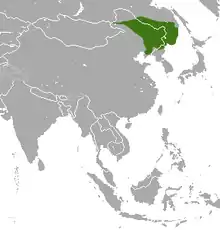 |
Size: 41–54 cm (16–21 in) long, plus 5–8 cm (2–3 in) tail[55] Habitat: Forest[56] Diet: Bark and twigs, as well as shrubs, herbs, and fruit[57] |
LC
|
| Mountain hare
|
L. timidus Linnaeus, 1758 Fifteen subspecies
|
Europe and northern Asia |
Size: 50–55 cm (20–22 in) long, plus 5–7 cm (2–3 in) tail[58] Habitat: Forest, shrubland, grassland, and inland wetlands[59] Diet: Seeds, berries, roots, twigs, and other plants[58] |
LC
|
| Scrub hare
|
L. saxatilis F. Cuvier, 1823 Two subspecies
|
Southern Africa |
Size: 45–65 cm (18–26 in) long[60] Habitat: Savanna, shrubland, grassland, and desert[61] Diet: Grass[61] |
LC
|
| Snowshoe hare
|
L. americanus Erxleben, 1777 Six subspecies
|
Northern North America |
Size: 38–51 cm (15–20 in) long, plus 4–6 cm (1.6–2.4 in) tail[62] Habitat: Forest and shrubland[63] Diet: Grass, forbs, sedges, and ferns[63] |
LC
|
| Tehuantepec jackrabbit
|
L. flavigularis Wagner, 1844 |
Small region of southern Mexico |
Size: 56–61 cm (22–24 in) long[64] Habitat: Savanna, shrubland, grassland, and coastal marine[65] Diet: Grass, as well as other plants[64] |
EN
|
| Tolai hare
|
L. tolai Pallas, 1778 Eight subspecies
|
Central and eastern Asia |
Size: 40–59 cm (16–23 in) long, plus 7–11 cm (3–4 in) tail[66] Habitat: Grassland and rocky areas[67] Diet: Roots, grass, and herbs[67] |
LC
|
| White-sided jackrabbit
|
L. callotis Wagler, 1830 Two subspecies
|
Southern North America |
Size: 43–60 cm (17–24 in) long, plus 4–10 cm (2–4 in) tail[68] Habitat: Shrubland and grassland[69] Diet: Grass and sedges[68] |
VU
|
| White-tailed jackrabbit
|
L. townsendii Bachman, 1839 Two subspecies
|
Central and northern North America |
Size: 53–60 cm (21–24 in) long[70] Habitat: Shrubland and grassland[71] Diet: Grass and forbs, as well as shrubs[71] |
LC
|
| Woolly hare
|
L. oiostolus Hodgson, 1840 Four subspecies
|
Central Asia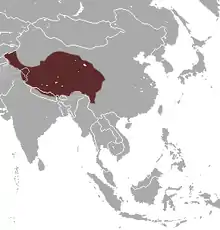 |
Size: 40–50 cm (16–20 in) long, plus 9 cm (4 in) tail[72] Habitat: Shrubland, grassland, and desert[73] Diet: Grass and leaves, as well as fruit and crops[72] |
LC
|
| Yarkand hare
|
L. yarkandensis Günther, 1875 |
Western China |
Size: 28–43 cm (11–17 in) long, plus 5–9 cm (2–4 in) tail[74] Habitat: Forest and shrubland[75] Diet: Grass and crops[75] |
NT
|
| Yunnan hare
|
L. comus Allen, 1927 |
Southern China |
Size: 28–43 cm (11–17 in) long, plus 5–9 cm (2–4 in) tail[76] Habitat: Grassland[77] Diet: Forbs and shrubs[78] |
LC
|
| Common name | Scientific name and subspecies | Range | Size and ecology | IUCN status and estimated population |
|---|---|---|---|---|
| Annamite striped rabbit | N. timminsi Averianov, Abramov, Tikhonov, 2000 |
Annamite Range in Southeastern Asia |
Size: 35–40 cm (14–16 in) long[79] Habitat: Forest[80] Diet: Unknown plants[79] |
EN
|
| Sumatran striped rabbit
|
N. netscheri (Schlegel, 1880) |
Sumatra |
Size: 36–42 cm (14–17 in) long, plus 17 cm (7 in) tail[30] Habitat: Forest[81] Diet: Cyrtandra plants[81] |
DD
|
| Common name | Scientific name and subspecies | Range | Size and ecology | IUCN status and estimated population |
|---|---|---|---|---|
| European rabbit
|
O. cuniculus (Linnaeus, 1758) Seven subspecies
|
Europe, southern South America, and Oceana (introduced in pink) |
Size: 38–50 cm (15–20 in) long[82] Habitat: Forest, savanna, shrubland, and grassland[83] Diet: Grass, leaves, buds, bark, and roots[82] |
EN
|
| Common name | Scientific name and subspecies | Range | Size and ecology | IUCN status and estimated population |
|---|---|---|---|---|
| Amami rabbit
|
P. furnessi (Stone, 1900) |
Southern tip of Japan |
Size: 39–53 cm (15–21 in) long, plus 2–4 cm (1–2 in) tail[84] Habitat: Forest, shrubland, and intertidal marine[85] Diet: Herbs, shrubs, and acorns[85] |
EN
|
| Common name | Scientific name and subspecies | Range | Size and ecology | IUCN status and estimated population |
|---|---|---|---|---|
| Bunyoro rabbit | P. marjorita (St. Leger, 1929) |
Central Africa |
Size: 45–50 cm (18–20 in) long, plus 4–5 cm (1.6–2.0 in) tail[86] Habitat: Forest, savanna, and rocky areas[87] Diet: Grass, shrubs, forbs, and tubers[86] |
LC
|
| Common name | Scientific name and subspecies | Range | Size and ecology | IUCN status and estimated population |
|---|---|---|---|---|
| Hewitt's red rock hare
|
P. saundersiae Hewitt, 1927 |
Southern Africa |
Size: 38–54 cm (15–21 in) long, plus 5–12 cm (2–5 in) tail[88] Habitat: Shrubland, grassland, and rocky areas[89] Diet: Grass[88] |
LC
|
| Jameson's red rock hare
|
P. randensis Jameson, 1907 Three subspecies
|
Southern Africa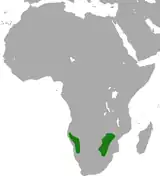 |
Size: 42–50 cm (17–20 in) long[90] Habitat: Shrubland, grassland, and rocky areas[91] Diet: Grass[90] |
LC
|
| Natal red rock hare
|
P. crassicaudatus (Geoffroy, 1832) Two subspecies
|
Southern Africa |
Size: 46–56 cm (18–22 in) long, plus 3–11 cm (1–4 in) tail[92] Habitat: Shrubland, grassland, and rocky areas[93] Diet: Grass[92] |
LC
|
| Smith's red rock hare
|
P. rupestris Smith, 1834 Five subspecies
|
Southern Africa |
Size: 38–54 cm (15–21 in) long, plus 5–12 cm (2–5 in) tail[94] Habitat: Grassland, rocky areas, and desert[95] Diet: Grass, herbs, and shrubs[96] |
LC
|
| Common name | Scientific name and subspecies | Range | Size and ecology | IUCN status and estimated population |
|---|---|---|---|---|
| Volcano rabbit
|
R. diazi (Ferrari-Pérez, 1893) |
Southern Mexico |
Size: 27–32 cm (11–13 in) long, plus 1–4 cm (0.4–1.6 in) tail[97] Habitat: Forest and grassland[98] Diet: Grass[97] |
EN
|
| Common name | Scientific name and subspecies | Range | Size and ecology | IUCN status and estimated population |
|---|---|---|---|---|
| Andean tapeti
|
S. andinus (Thomas, 1897) |
Northern Andes | Size: 33–36 cm (13–14 in) long, plus 2–4 cm (1–2 in) tail[99] Habitat: Grassland[100] Diet: Grass and sedges[100] |
DD
|
| Appalachian cottontail
|
S. obscurus Chapman, Cramer, Dippenaar, Robinson, 1992 |
Eastern America |
Size: 32–41 cm (13–16 in) long, plus 2–7 cm (1–3 in) tail[101] Habitat: Forest, shrubland, and inland wetlands[102] Diet: Ferns, grass, forbs, shrubs, and conifer needles[102] |
NT
|
| Brush rabbit
|
S. bachmani (Waterhouse, 1839) Six subspecies
|
Western North America |
Size: 30–37 cm (12–15 in) long, plus 1–3 cm (0.4–1.2 in) tail[103] Habitat: Forest, shrubland, grassland, inland wetlands, and desert[104] Diet: Grass, as well as other plants[104] |
LC
|
| Central American tapeti | S. gabbi (Allen, 1877) |
Central America | Size: Unknown[105] Habitat: Forest[106] Diet: Unknown plants[105] |
LC
|
| Coastal tapeti | S. tapetillus Thomas, 1913 |
Rio de Janeiro, Brazil | Size: Unknown[107] Habitat: Grassland[108] Diet: Unknown plants[107] |
VU
|
| Common tapeti
|
S. brasiliensis (Linnaeus, 1758) Seventeen subspecies
|
Northeastern Brazil | Size: Unknown[105] Habitat: Forest[109] Diet: Unknown plants[105] |
EN
|
| Davis Mountains cottontail
|
S. robustus Bailey, 1905 |
Mexico and southern United States | Size: Unknown[110] Habitat: Forest[110] Diet: Unknown plants[110] |
VU
|
| Desert cottontail
|
S. audubonii (Baird, 1858) Seven subspecies
|
Western North America |
Size: 37–40 cm (15–16 in) long, plus 5–6 cm (2.0–2.4 in) tail[111] Habitat: Forest, shrubland, grassland, and desert[112] Diet: Forbs, grass, and shrubs[112] |
LC
|
| Dice's cottontail | S. dicei Harris Jr., 1932 |
Costa Rica and Panama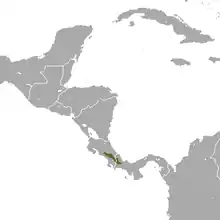 |
Size: 34–45 cm (13–18 in) long, plus 2–4 cm (1–2 in) tail[113] Habitat: Forest, shrubland, and grassland[114] Diet: Unknown plants[113] |
VU
|
| Eastern cottontail
|
S. floridanus (Allen, 1890) Seventeen subspecies
|
North America, Central America, and northern South America |
Size: 39–48 cm (15–19 in) long, plus 2–7 cm (1–3 in) tail[115] Habitat: Forest, savanna, shrubland, grassland, inland wetlands, rocky areas, and desert[116] Diet: Variety of plants[116] |
LC
|
| Marsh rabbit
|
S. palustris (Bachman, 1837) Three subspecies
|
Eastern America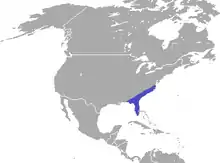 |
Size: 42–44 cm (17–17 in) long[117] Habitat: Forest, grassland, inland wetlands, and intertidal marine[118] Diet: Berries, rhizomes, bulbs, grass, and other plants[117] |
LC
|
| Mexican cottontail
|
S. cunicularius (Horsfield, 1848) Two subspecies
|
Southern Mexico |
Size: 48–52 cm (19–20 in) long, plus 5–7 cm (2–3 in) tail[119] Habitat: Forest, shrubland, grassland, and desert[120] Diet: Unknown plants[119] |
LC
|
| Mountain cottontail
|
S. nuttallii (Bachman, 1837) Three subspecies
|
Western North America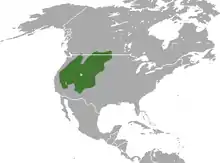 |
Size: 28–36 cm (11–14 in) long, plus 3–6 cm (1–2 in) tail[121] Habitat: Forest and shrubland[122] Diet: Sagebrush and grass[123] |
LC
|
| New England cottontail
|
S. transitionalis (Bangs, 1895) |
New England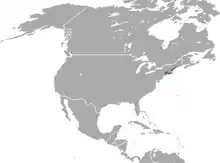 |
Size: 39–44 cm (15–17 in) long[124] Habitat: Forest, shrubland, and inland wetlands[125] Diet: Grass, forbs, and twigs[124] |
VU
|
| Omilteme cottontail | S. insonus Nelson, 1904 |
Sierra Madre del Sur in Mexico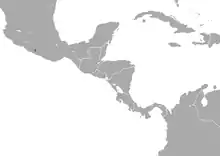 |
Size: 39–44 cm (15–17 in) long, plus 4–5 cm (1.6–2.0 in) tail[126] Habitat: Forest[126] Diet: Unknown plants[126] |
DD
|
| Santa Marta tapeti | S. sanctaemartae Hershkovitz, 1950 |
Columbia | Size: Unknown[105] Habitat: Forest, grassland[105] Diet: Unknown plants[105] |
DD
|
| Swamp rabbit
|
S. aquaticus (Bachman, 1837) Two subspecies
|
Southern America |
Size: 45–55 cm (18–22 in) long, plus 5–8 cm (2–3 in) tail[128] Habitat: Forest, shrubland, grassland, and inland wetlands[129] Diet: Grass, sedges, shrubs, bark, seedlings, and twigs[130] |
LC
|
| Tres Marias cottontail | S. graysoni (Allen, 1877) |
Southwestern Mexico |
Size: 21–48 cm (8–19 in) long, plus 1–6 cm (0.4–2.4 in) tail[131] Habitat: Forest, savanna, and shrubland[132] Diet: Wide variety of plants[131] |
EN
|
| Venezuelan lowland rabbit | S. varynaensis Durant, Guevara, 2001 |
Venezuela |
Size: 41–49 cm (16–19 in) long, plus 2–3 cm (0.8–1.2 in) tail[133] Habitat: Forest and savanna[134] Diet: Sida plants[134] |
DD
|
References
- ↑ "Fossilworks: Leporidae". Paleobiology Database. University of Wisconsin–Madison. Archived from the original on December 12, 2021. Retrieved December 17, 2021.
- ↑ Wilson, Reeder, pp. 194–211
- 1 2 Rohde, Ashley (2006). "Brachylagus idahoensis". Animal Diversity Web. University of Michigan. Archived from the original on October 23, 2021. Retrieved October 22, 2021.
- 1 2 Rachlow, J.; Becker, P. A.; Shipley, L. (2016). "Brachylagus idahoensis". IUCN Red List of Threatened Species. 2016: e.T2963A45176206. doi:10.2305/IUCN.UK.2016-3.RLTS.T2963A45176206.en.
- ↑ Smith, Johnston, Alves, Hackländer, p. 91
- 1 2 3 Collins, K.; Bragg, C.; Birss, C. (2019). "Bunolagus monticularis". IUCN Red List of Threatened Species. 2019: e.T3326A45176532. doi:10.2305/IUCN.UK.2019-1.RLTS.T3326A45176532.en.
- ↑ Smith, Johnston, Alves, Hackländer, p. 94
- 1 2 3 Aryal, A.; Yadav, B. (2019). "Caprolagus hispidus". IUCN Red List of Threatened Species. 2019: e.T3833A45176688. doi:10.2305/IUCN.UK.2019-1.RLTS.T3833A45176688.en.
- 1 2 Nickolai, Ashley (2014). "Lepus habessinicus". Animal Diversity Web. University of Michigan. Archived from the original on October 23, 2021. Retrieved October 22, 2021.
- 1 2 Johnston, C. H.; Tolesa, Z. (2019). "Lepus habessinicus". IUCN Red List of Threatened Species. 2019: e.T41289A45189637. doi:10.2305/IUCN.UK.2019-1.RLTS.T41289A45189637.en.
- ↑ Riegler, Donald (2013). "Lepus microtis". Animal Diversity Web. University of Michigan. Archived from the original on November 5, 2021. Retrieved November 5, 2021.
- 1 2 3 Johnston, C. H.; Robinson, T. J.; Relton, C.; Child, M. F.; Smith, A. T. (2019). "Lepus victoriae". IUCN Red List of Threatened Species. 2019: e.T41879A45194215. doi:10.2305/IUCN.UK.2019-1.RLTS.T41879A45194215.en.
- ↑ Smith, Johnston, Alves, Hackländer, p. 204
- 1 2 3 Smith, A. T.; Johnston, C. H. (2019). "Lepus othus". IUCN Red List of Threatened Species. 2019: e.T11795A45178124. doi:10.2305/IUCN.UK.2019-1.RLTS.T11795A45178124.en.
- ↑ Smith, Johnston, Alves, Hackländer, p. 160
- 1 2 3 Lorenzo, C.; Brown, D. E. (2019). "Lepus alleni". IUCN Red List of Threatened Species. 2019: e.T41272A45185265. doi:10.2305/IUCN.UK.2019-1.RLTS.T41272A45185265.en.
- ↑ Smith, Johnston, Alves, Hackländer, p. 166
- 1 2 3 Smith, A. T.; Johnston, C. H. (2019). "Lepus arcticus". IUCN Red List of Threatened Species. 2019: e.T41274A45185887. doi:10.2305/IUCN.UK.2019-1.RLTS.T41274A45185887.en.
- ↑ Smith, Johnston, Alves, Hackländer, p. 198
- 1 2 Lorenzo, C.; Johnston, C. H. (2019). "Lepus insularis". IUCN Red List of Threatened Species. 2019: e.T11794A45177986. doi:10.2305/IUCN.UK.2019-3.RLTS.T11794A45177986.en.
- ↑ Mejia, Joseph R. (1999). "Lepus insularis". Animal Diversity Web. University of Michigan. Archived from the original on October 23, 2021. Retrieved October 22, 2021.
- 1 2 Ballenger, Liz (1999). "Lepus californicus". Animal Diversity Web. University of Michigan. Archived from the original on October 23, 2021. Retrieved October 22, 2021.
- 1 2 Brown, D. E.; Lorenzo, C.; Álvarez-Castañeda, S. T. (2019). "Lepus californicus". IUCN Red List of Threatened Species. 2019: e.T41276A45186309. doi:10.2305/IUCN.UK.2019-1.RLTS.T41276A45186309.en.
- ↑ Smith, Johnston, Alves, Hackländer, p. 179
- 1 2 3 Ballesteros, F.; Smith, A. T. (2019). "Lepus castroviejoi". IUCN Red List of Threatened Species. 2019: e.T11797A503908. doi:10.2305/IUCN.UK.2019-2.RLTS.T11797A503908.en.
- ↑ Smith, Johnston, Alves, Hackländer, p. 205
- 1 2 3 Johnston, C. H.; Smith, A. T. (2019). "Lepus peguensis". IUCN Red List of Threatened Species. 2019: e.T41284A45188632. doi:10.2305/IUCN.UK.2019-1.RLTS.T41284A45188632.en.
- ↑ Begnoche, Dana (2002). "Lepus capensis". Animal Diversity Web. University of Michigan. Archived from the original on November 5, 2021. Retrieved November 5, 2021.
- 1 2 3 Johnston, C. H.; Robinson, T. J.; Child, M. F.; Relton, C. (2019). "Lepus capensis". IUCN Red List of Threatened Species. 2019: e.T41277A45186750. doi:10.2305/IUCN.UK.2019-1.RLTS.T41277A45186750.en.
- 1 2 Smith, Johnston, Alves, Hackländer, p. 96
- 1 2 3 Smith, A. T.; Johnston, C. H. (2019). "Lepus sinensis". IUCN Red List of Threatened Species. 2019: e.T41286A45189035. doi:10.2305/IUCN.UK.2019-1.RLTS.T41286A45189035.en.
- 1 2 Cooper, Thomas (2015). "Lepus corsicanus". Animal Diversity Web. University of Michigan. Archived from the original on October 23, 2021. Retrieved October 22, 2021.
- 1 2 Randi, E.; Riga, F. (2019). "Lepus corsicanus". IUCN Red List of Threatened Species. 2019: e.T41305A2952954. doi:10.2305/IUCN.UK.2019-2.RLTS.T41305A2952954.en.
- 1 2 Sullivan, Shaunna (2013). "Lepus tibetanus". Animal Diversity Web. University of Michigan. Archived from the original on October 23, 2021. Retrieved October 22, 2021.
- 1 2 Smith, A. T.; Johnston, C. H. (2019). "Lepus tibetanus". IUCN Red List of Threatened Species. 2019: e.T41307A45193298. doi:10.2305/IUCN.UK.2019-1.RLTS.T41307A45193298.en.
- ↑ Smith, Johnston, Alves, Hackländer, p. 190
- 1 2 3 Johnston, C. H.; Tolesa, Z. (2019). "Lepus fagani". IUCN Red List of Threatened Species. 2019: e.T11798A45178437. doi:10.2305/IUCN.UK.2019-1.RLTS.T11798A45178437.en.
- ↑ Kingdon, p. 310
- 1 2 3 Johnston, C. H.; Tolesa, Z. (2019). "Lepus starcki". IUCN Red List of Threatened Species. 2019: e.T41287A45189235. doi:10.2305/IUCN.UK.2019-1.RLTS.T41287A45189235.en.
- 1 2 Vu, Alan (2001). "Lepus europaeus". Animal Diversity Web. University of Michigan. Archived from the original on October 23, 2021. Retrieved October 22, 2021.
- 1 2 Hacklander, K.; Schai-Braun, S. (2019). "Lepus europaeus". IUCN Red List of Threatened Species. 2019: e.T41280A45187424. doi:10.2305/IUCN.UK.2019-1.RLTS.T41280A45187424.en.
- ↑ Smith, Johnston, Alves, Hackländer, p. 193
- 1 2 Soriguer, R.; Carro, F. (2019). "Lepus granatensis". IUCN Red List of Threatened Species. 2019: e.T41306A2953195. doi:10.2305/IUCN.UK.2019-1.RLTS.T41306A2953195.en.
- ↑ Weaver, Derek (2013). "Lepus granatensis". Animal Diversity Web. University of Michigan. Archived from the original on November 5, 2021. Retrieved November 5, 2021.
- ↑ Smith, Johnston, Alves, Hackländer, p. 197
- 1 2 Smith, A. T.; Johnston, C. (2016). "Lepus hainanus". IUCN Red List of Threatened Species. 2016: e.T11793A45177783. doi:10.2305/IUCN.UK.2016-3.RLTS.T11793A45177783.en.
- ↑ Lundberg, Annette (2013). "Lepus hainanus". Animal Diversity Web. University of Michigan. Archived from the original on November 5, 2021. Retrieved November 5, 2021.
- 1 2 Lundrigan, Barbara; Foote, Sarah (2003). "Lepus nigricollis". Animal Diversity Web. University of Michigan. Archived from the original on October 23, 2021. Retrieved October 22, 2021.
- 1 2 Nameer, P. O.; Smith, A. T. (2019). "Lepus nigricollis". IUCN Red List of Threatened Species. 2019: e.T41282A45188041. doi:10.2305/IUCN.UK.2019-1.RLTS.T41282A45188041.en.
- ↑ Smith, Johnston, Alves, Hackländer, p. 169
- 1 2 Yamada, F.; Smith, A. T. (2019). "Lepus brachyurus". IUCN Red List of Threatened Species. 2019: e.T41275A45186064. doi:10.2305/IUCN.UK.2019-1.RLTS.T41275A45186064.en.
- ↑ Holmberg, Jennifer (2014). "Lepus brachyurus". Animal Diversity Web. University of Michigan. Archived from the original on November 5, 2021. Retrieved November 5, 2021.
- 1 2 Faigle, Stacy (2014). "Lepus coreanus". Animal Diversity Web. University of Michigan. Archived from the original on October 23, 2021. Retrieved October 22, 2021.
- 1 2 Jo, Y.-S.; Smith, A. T. (2019) [errata version of 2019 assessment]. "Lepus coreanus". IUCN Red List of Threatened Species. 2019: e.T41279A161750768. doi:10.2305/IUCN.UK.2019-1.RLTS.T41279A161750768.en.
- ↑ Smith, Johnston, Alves, Hackländer, p. 200
- 1 2 Smith, A. T.; Johnston, C. H. (2019). "Lepus mandshuricus". IUCN Red List of Threatened Species. 2019: e.T41281A45187882. doi:10.2305/IUCN.UK.2019-1.RLTS.T41281A45187882.en.
- ↑ Smith, Xie, et al., p. 289
- 1 2 Smith, Johnston, Alves, Hackländer, pp. 212–213
- 1 2 Smith, A. T.; Johnston, C. H. (2019). "Lepus timidus". IUCN Red List of Threatened Species. 2019: e.T11791A45177198. doi:10.2305/IUCN.UK.2019-1.RLTS.T11791A45177198.en.
- ↑ Kushnereit, Aimee (2004). "Lepus saxatilis". Animal Diversity Web. University of Michigan. Archived from the original on November 5, 2021. Retrieved November 5, 2021.
- 1 2 3 Robinson, T. J.; Child, M. F.; Relton, C.; Johnston, C. H. (2019). "Lepus saxatilis". IUCN Red List of Threatened Species. 2019: e.T41285A45188827. doi:10.2305/IUCN.UK.2019-1.RLTS.T41285A45188827.en.
- ↑ Smith, Johnston, Alves, Hackländer, p. 163
- 1 2 3 Mills, L.; Smith, A. T. (2019). "Lepus americanus". IUCN Red List of Threatened Species. 2019: e.T41273A45185466. doi:10.2305/IUCN.UK.2019-1.RLTS.T41273A45185466.en.
- 1 2 Warlin, Sierra (2013). "Lepus flavigularis". Animal Diversity Web. University of Michigan. Archived from the original on October 23, 2021. Retrieved October 22, 2021.
- 1 2 Lorenzo, C.; Smith, A. T. (2019). "Lepus flavigularis". IUCN Red List of Threatened Species. 2019: e.T11790A45176906. doi:10.2305/IUCN.UK.2019-3.RLTS.T11790A45176906.en.
- ↑ Smith, Xie, et al., p. 291
- 1 2 3 Smith, A. T.; Johnston, C. H. (2019). "Lepus tolai". IUCN Red List of Threatened Species. 2019: e.T41308A45193447. doi:10.2305/IUCN.UK.2019-1.RLTS.T41308A45193447.en.
- 1 2 Dharmani, Aarti (2000). "Lepus callotis". Animal Diversity Web. University of Michigan. Archived from the original on October 23, 2021. Retrieved October 22, 2021.
- 1 2 Brown, D. E.; Smith, A. T. (2019). "Lepus callotis". IUCN Red List of Threatened Species. 2019: e.T11792A45177499. doi:10.2305/IUCN.UK.2019-2.RLTS.T11792A45177499.en.
- ↑ Verts, Carraway, p. 142
- 1 2 3 Brown, D. E.; Smith, A. T. (2019). "Lepus townsendii". IUCN Red List of Threatened Species. 2019: e.T41288A45189364. doi:10.2305/IUCN.UK.2019-1.RLTS.T41288A45189364.en.
- 1 2 Ng, Jarita (2011). "Lepus oiostolus". Animal Diversity Web. University of Michigan. Archived from the original on October 23, 2021. Retrieved October 22, 2021.
- 1 2 Smith, A. T.; Johnston, C. H. (2019). "Lepus oiostolus". IUCN Red List of Threatened Species. 2019: e.T41283A45188432. doi:10.2305/IUCN.UK.2019-1.RLTS.T41283A45188432.en.
- ↑ Smith, Xie, et al., p. 292
- 1 2 3 Smith, A. T.; Johnston, C. H. (2017) [errata version of 2016 assessment]. "Lepus yarkandensis". IUCN Red List of Threatened Species. 2016: e.T11796A115103994. doi:10.2305/IUCN.UK.2016-3.RLTS.T11796A45178274.en.
- ↑ Smith, Johnston, Alves, Hackländer, p. 222
- 1 2 Smith, A. T.; Johnston, C. H. (2019). "Lepus comus". IUCN Red List of Threatened Species. 2019: e.T41278A45187160. doi:10.2305/IUCN.UK.2019-1.RLTS.T41278A45187160.en.
- ↑ Smith, Xie, et al., p. 287
- 1 2 Hoedl, Amanda (2012). "Nesolagus timminsi". Animal Diversity Web. University of Michigan. Archived from the original on October 23, 2021. Retrieved October 22, 2021.
- 1 2 Tilker, A.; Timmins, R. J.; Nguyen The Truong, A.; Coudrat, C. N. Z.; Gray, T.; Le Trong Trai, Willcox; D. H. A., Abramov; A. V., Wilkinson; N., Steinmetz; R. (2019). "Nesolagus timminsi". IUCN Red List of Threatened Species. 2019: e.T41209A45181925. doi:10.2305/IUCN.UK.2019-1.RLTS.T41209A45181925.en.
- 1 2 3 McCarthy, J.; Holden, J.; Martyr, D.; McCarthy, K. (2019). "Nesolagus netscheri". IUCN Red List of Threatened Species. 2019: e.T14662A45178557. doi:10.2305/IUCN.UK.2019-2.RLTS.T14662A45178557.en.
- 1 2 Tislerics, Ati (2000). "Oryctolagus cuniculus". Animal Diversity Web. University of Michigan. Archived from the original on October 23, 2021. Retrieved October 22, 2021.
- 1 2 Villafuerte, R.; Delibes-Mateos, M. (2020) [errata version of 2019 assessment]. "Oryctolagus cuniculus". IUCN Red List of Threatened Species. 2019: e.T41291A170619657. doi:10.2305/IUCN.UK.2019-3.RLTS.T41291A170619657.en.
- ↑ Smith, Johnston, Alves, Hackländer, p. 105
- 1 2 3 Yamada, F. and Smith; A. T. (2016). "Pentalagus furnessi". IUCN Red List of Threatened Species. 2016: e.T16559A45180151. doi:10.2305/IUCN.UK.2016-3.RLTS.T16559A45180151.en.
- 1 2 Portman, Charles (2004). "Poelagus marjorita". Animal Diversity Web. University of Michigan. Archived from the original on October 23, 2021. Retrieved October 22, 2021.
- 1 2 Johnston, C. H.; Smith, A. T. (2019). "Poelagus marjorita". IUCN Red List of Threatened Species. 2019: e.T41292A45189965. doi:10.2305/IUCN.UK.2019-1.RLTS.T41292A45189965.en.
- 1 2 Smith, Johnston, Alves, Hackländer, p. 113
- 1 2 Robinson, T. J.; Child, M. F.; Matthee, C. M. (2019). "Pronolagus saundersiae". IUCN Red List of Threatened Species. 2019: e.T136713A45194657. doi:10.2305/IUCN.UK.2019-1.RLTS.T136713A45194657.en.
- 1 2 Bartel, Riley (2015). "Pronolagus randensis". Animal Diversity Web. University of Michigan. Archived from the original on October 23, 2021. Retrieved October 22, 2021.
- 1 2 Child, M. F.; Matthee, C. M.; Robinson, T. J. (2019). "Pronolagus randensis". IUCN Red List of Threatened Species. 2019: e.T41294A45190258. doi:10.2305/IUCN.UK.2019-1.RLTS.T41294A45190258.en.
- 1 2 Smith, Johnston, Alves, Hackländer, p. 109
- 1 2 Child, M. F.; Matthee, C. M.; Robinson, T. J. (2019). "Pronolagus crassicaudatus". IUCN Red List of Threatened Species. 2019: e.T41293A45190100. doi:10.2305/IUCN.UK.2019-1.RLTS.T41293A45190100.en.
- ↑ Smith, Johnston, Alves, Hackländer, p. 112
- 1 2 Child, M. F.; Matthee, C. M.; Robinson, T. J. (2019). "Pronolagus rupestris". IUCN Red List of Threatened Species. 2019: e.T41295A45190415. doi:10.2305/IUCN.UK.2019-1.RLTS.T41295A45190415.en.
- ↑ Sekine, Ryo (2000). "Pronolagus rupestris". Animal Diversity Web. University of Michigan. Archived from the original on November 8, 2021. Retrieved November 8, 2021.
- 1 2 Smith, Johnston, Alves, Hackländer, pp. 114–115
- 1 2 Velázquez, A.; Guerrero, J. A. (2019). "Romerolagus diazi". IUCN Red List of Threatened Species. 2019: e.T19742A45180356. doi:10.2305/IUCN.UK.2019-2.RLTS.T19742A45180356.en.
- ↑ Smith, Johnston, Alves, Hackländer, p. 127
- 1 2 3 Ruedas, L. A.; Smith, A. T. (2020) [errata version of 2019 assessment]. "Sylvilagus andinus". IUCN Red List of Threatened Species. 2019: e.T142541491A165117323. doi:10.2305/IUCN.UK.2019-2.RLTS.T142541491A165117323.en.
- ↑ Kurta, p. 96
- 1 2 3 Barry, R.; Lanier, H. C. (2019). "Sylvilagus obscurus". IUCN Red List of Threatened Species. 2019: e.T41301A45192437. doi:10.2305/IUCN.UK.2019-2.RLTS.T41301A45192437.en.
- ↑ Smith, Johnston, Alves, Hackländer, p. 123
- 1 2 3 Kelly, P. A.; Lorenzo, C.; Alvarez-Castaneda, S. T. (2019). "Sylvilagus bachmani". IUCN Red List of Threatened Species. 2019: e.T41302A45192710. doi:10.2305/IUCN.UK.2019-1.RLTS.T41302A45192710.en.
- 1 2 3 4 5 6 7 Ruedas, L. A.; Marques, S. S.; French, J. H.; Platt II, R. N.; Salazar-Bravo, J.; Mora, J. M.; Thompson, C. W. (October 22, 2019). "Taxonomy of the Sylvilagus brasiliensis complex in Central and South America (Lagomorpha: Leporidae)". Journal of Mammalogy. 100 (5): 1599–1630. doi:10.1093/jmammal/gyz126.
- 1 2 Ruedas, L.; Smith, A. T. (2019). "Sylvilagus gabbi". IUCN Red List of Threatened Species. 2019: e.T87491157A87491160. doi:10.2305/IUCN.UK.2019-1.RLTS.T87491157A87491160.en.
- 1 2 Ruedas, L. A.; Marques, S. S.; French, J. H.; Platt II, R. N.; Salazar-Bravo, J.; Mora, J. M.; Thompson, C. W. (February 9, 2017). "A Prolegomenon to the Systematics of South American Cottontail Rabbits (Mammalia, Lagomorpha Leporidae: Sylvilagus)". Miscellaneous Publications of the Museum of Zoology, University of Michigan. 205. ISSN 0076-8405.
- 1 2 Ruedas, L. A.; Smith, A. T. (2020) [errata version of 2019 assessment]. "Sylvilagus tapetillus". IUCN Red List of Threatened Species. 2019: e.T142542759A165117046. doi:10.2305/IUCN.UK.2019-3.RLTS.T142542759A165117046.en.
- 1 2 Ruedas, L.; Smith, A. T. (2019). "Sylvilagus brasiliensis". IUCN Red List of Threatened Species. 2019: e.T87491102A45191186. doi:10.2305/IUCN.UK.2019-2.RLTS.T87491102A45191186.en.
- 1 2 3 4 Ruedas, L. A.; Smith, A. T. (2020) [errata version of 2019 assessment]. "Sylvilagus robustus". IUCN Red List of Threatened Species. 2019: e.T41310A165116781. doi:10.2305/IUCN.UK.2019-3.RLTS.T41310A165116781.en.
- ↑ Smith, Johnston, Alves, Hackländer, p. 120
- 1 2 3 Smith, A. T.; Brown, D. E. (2019). "Sylvilagus audubonii". IUCN Red List of Threatened Species. 2019: e.T41297A45190821. doi:10.2305/IUCN.UK.2019-1.RLTS.T41297A45190821.en.
- 1 2 Smith, Johnston, Alves, Hackländer, p. 136
- 1 2 Mora, J. M.; Ruedas, L. and Smith; A. T. (2016). "Sylvilagus dicei". IUCN Red List of Threatened Species. 2016: e.T21209A45180947. doi:10.2305/IUCN.UK.2016-3.RLTS.T21209A45180947.en.
- ↑ Smith, Johnston, Alves, Hackländer, p. 138
- 1 2 3 Nielsen, C.; Lanier, H. C. (2019). "Sylvilagus floridanus". IUCN Red List of Threatened Species. 2019: e.T41299A45191626. doi:10.2305/IUCN.UK.2019-1.RLTS.T41299A45191626.en.
- 1 2 Thompson, Leah (2008). "Sylvilagus palustris". Animal Diversity Web. University of Michigan. Archived from the original on October 23, 2021. Retrieved October 22, 2021.
- 1 2 McCleery, R.; Lanier, H. C. (2019). "Sylvilagus palustris". IUCN Red List of Threatened Species. 2019: e.T41303A45192995. doi:10.2305/IUCN.UK.2019-1.RLTS.T41303A45192995.en.
- 1 2 Smith, Johnston, Alves, Hackländer, p. 132
- 1 2 Lorenzo, C.; Lanier, H. C. (2019). "Sylvilagus cunicularius". IUCN Red List of Threatened Species. 2019: e.T21211A45181292. doi:10.2305/IUCN.UK.2019-1.RLTS.T21211A45181292.en.
- ↑ Feldhamer, Carlyle, Chapman, p. 104
- 1 2 Smith, A. T.; Brown, D. E. (2019). "Sylvilagus nuttallii". IUCN Red List of Threatened Species. 2019: e.T41300A45192243. doi:10.2305/IUCN.UK.2019-1.RLTS.T41300A45192243.en.
- ↑ "Mountain Cottontail – Sylvilagus nuttallii". Montana Field Guide. Montana Department of Fish, Wildlife and Parks. Archived from the original on November 8, 2021. Retrieved November 8, 2021.
- 1 2 Berenson, Tessa (2012). "Sylvilagus transitionalis". Animal Diversity Web. University of Michigan. Archived from the original on October 23, 2021. Retrieved October 22, 2021.
- 1 2 Litvaitis, J.; Lanier, H. C. (2019). "Sylvilagus transitionalis". IUCN Red List of Threatened Species. 2019: e.T21212A45181534. doi:10.2305/IUCN.UK.2019-2.RLTS.T21212A45181534.en.
- 1 2 3 4 Lorenzo, C.; Brown, D. E.; Lanier, H. C. (2019). "Sylvilagus insonus". IUCN Red List of Threatened Species. 2019: e.T21207A45180771. doi:10.2305/IUCN.UK.2019-2.RLTS.T21207A45180771.en.
- ↑ Ruedas, L. A.; Smith, A. T. (2020) [errata version of 2019 assessment]. "Sylvilagus sanctaemartae". IUCN Red List of Threatened Species. 2019: e.T142642715A165117201. doi:10.2305/IUCN.UK.2019-3.RLTS.T142642715A165117201.en.
- ↑ Smith, Johnston, Alves, Hackländer, p. 118
- 1 2 Lanier, H. C.; Nielsen, C. (2019). "Sylvilagus aquaticus". IUCN Red List of Threatened Species. 2019: e.T41296A45190578. doi:10.2305/IUCN.UK.2019-1.RLTS.T41296A45190578.en.
- ↑ Roszko, Annamarie (2007). "Sylvilagus aquaticus". Animal Diversity Web. University of Michigan. Archived from the original on October 23, 2021. Retrieved October 22, 2021.
- 1 2 Viswanathan, Lata (2000). "Sylvilagus graysoni". Animal Diversity Web. University of Michigan. Archived from the original on October 23, 2021. Retrieved October 22, 2021.
- 1 2 Lorenzo, C.; Lanier, H. C. (2019). "Sylvilagus graysoni". IUCN Red List of Threatened Species. 2019: e.T21206A45180643. doi:10.2305/IUCN.UK.2019-3.RLTS.T21206A45180643.en.
- ↑ Durant, P.; Guevara, M. A. (March 2001). "A new rabbit species (Sylvilagus, Mammalia: Leporidae) from the lowlands of Venezuela". Revista de Biología Tropical. 49 (1).
- 1 2 3 Johnston, C. H.; Smith, A. T. (2019). "Sylvilagus varynaensis". IUCN Red List of Threatened Species. 2019: e.T41311A45193972. doi:10.2305/IUCN.UK.2019-1.RLTS.T41311A45193972.en.
Sources
- Feldhamer, George A.; Thompson, Bruce Carlyle; Chapman, Joseph A. (2003). Wild Mammals of North America. Johns Hopkins University Press. ISBN 978-0-8018-7416-1.
- Kingdon, Jonathan (2015). The Kingdon Field Guide to African Mammals (Second ed.). Bloomsbury Publishing. ISBN 978-1-4729-2531-2.
- Kurta, Allen (1995). Mammals of the Great Lakes Region. University of Michigan Press. ISBN 978-0-472-06497-7.
- Smith, Andrew T.; Johnston, Charlotte H.; Alves, Paolo C.; Hackländer, Klaus, eds. (2018). Lagomorphs: Pikas, Rabbits, and Hares of the World. Johns Hopkins University Press. ISBN 978-1-4214-2340-1.
- Smith, Andrew T.; Xie, Yan; Hoffmann, Robert S.; Lunde, Darrin; MacKinnon, John; Wilson, Don E.; Wozencraft, W. Chris, eds. (2010). A Guide to the Mammals of China. Princeton University Press. ISBN 978-1-4008-3411-2.
- Verts, B. J.; Carraway, Leslie N. (1998). Land Mammals of Oregon. University of California Press. ISBN 978-0-520-21199-5.
- Hoffmann, Robert S.; Smith, Andrew T. (2005). Wilson, Don E.; Reeder, DeeAnn M. (eds.). Mammal Species of the World. Vol. 1 (3rd ed.). Johns Hopkins University Press. ISBN 978-0-8018-8221-0.



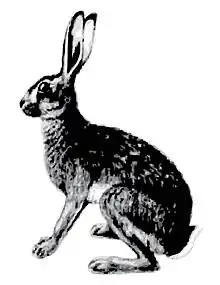








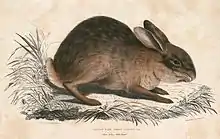
.jpeg.webp)
.jpg.webp)
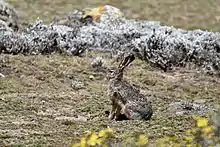
-cropped.jpg.webp)
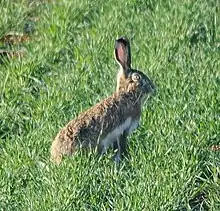

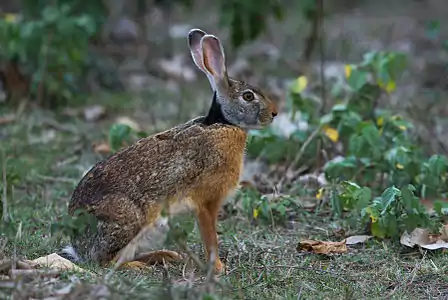






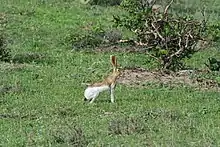
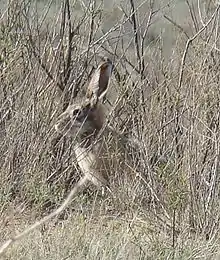





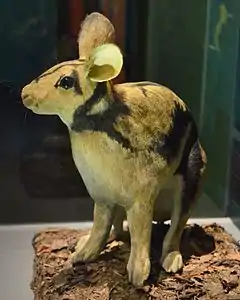

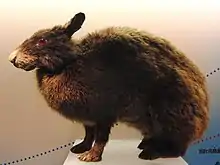




_001.jpg.webp)
.jpg.webp)

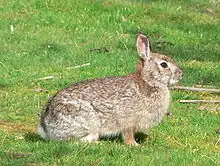


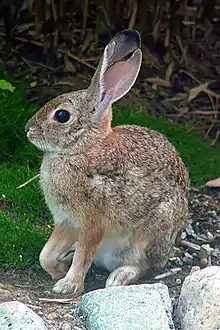
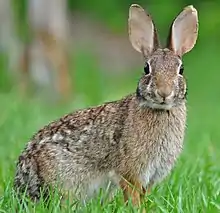
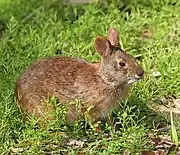

.jpg.webp)
.jpg.webp)
.jpg.webp)